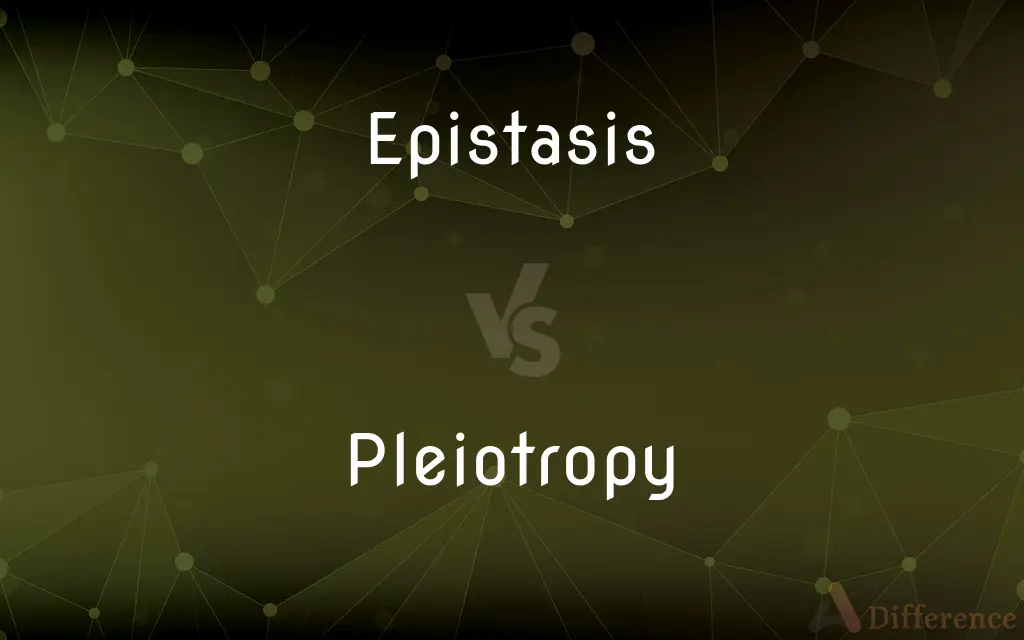Epistasis vs. Pleiotropy — What's the Difference?
By Tayyaba Rehman & Fiza Rafique — Updated on March 15, 2024
Epistasis involves the interaction between genes, where one gene affects the expression of another, while pleiotropy refers to a single gene influencing multiple traits.

Difference Between Epistasis and Pleiotropy
Table of Contents
ADVERTISEMENT
Key Differences
Epistasis occurs when the expression of one gene is dependent on the presence or absence of one or more modifier genes. Pleiotropy, on the other hand, describes a situation where a single gene influences multiple phenotypic traits.
While epistasis is about the interaction and hierarchical relationship between different genes, pleiotropy focuses on the breadth of impact a single gene can have on the organism. Epistasis can significantly complicate breeding and genetic prediction efforts, as the interaction between genes can lead to unexpected phenotypes. Pleiotropy, meanwhile, underscores the complexity of genetic architecture, illustrating how changes in a single genetic element can have widespread implications for an organism's physiology and health.
Both epistasis and pleiotropy are fundamental concepts in genetics that highlight the complexity of genetic interactions and their effects on phenotypes. They play critical roles in the study of genetics, evolution, and medicine, helping scientists understand the intricate relationships between genes and traits, as well as the genetic basis of diseases and disorders.
Comparison Chart
Definition
One gene's expression affects another's
A single gene influences multiple traits
Genetic Interaction
Between two or more genes
Within a single gene
ADVERTISEMENT
Phenotypic Effect
Can mask or modify another gene's effect
Leads to multiple effects from one gene
Examples
Coat color in animals, disease resistance
Marfan syndrome, sickle cell disease
Impact on Genetics
Complicates genetic analysis and breeding
Indicates a gene's broad physiological role
Compare with Definitions
Epistasis
Epistasis refers to the effect of one gene being dependent on another.
In Labrador retrievers, a gene determines coat color, while another can override this, resulting in different coloration.
Pleiotropy
Pleiotropy occurs when a single gene influences multiple traits.
The gene causing Marfan syndrome affects the skeletal, ocular, and cardiovascular systems.
Epistasis
Influences genetic variation and evolution.
Epistatic interactions can lead to new phenotypic variations, driving evolutionary change.
Pleiotropy
It demonstrates the interconnectedness of biological systems.
Pleiotropic effects reveal how genetic mutations can lead to complex syndromes.
Epistasis
Epistasis is key in understanding complex genetic traits.
Geneticists study epistatic interactions to unravel complex disease genetics.
Pleiotropy
Vital for understanding genetic diseases.
Research into pleiotropy helps explain the varied symptoms of genetic disorders.
Epistasis
Complicates predictions in genetic breeding.
Breeders must consider epistatic interactions when selecting for specific traits.
Pleiotropy
Can complicate disease management and treatment.
Treating one symptom of a pleiotropic gene mutation might impact others.
Epistasis
It can mask the expression of other genes.
The albino trait in plants can hide the expression of genes determining pigment color.
Pleiotropy
Influences evolutionary strategies and fitness.
A gene that provides multiple beneficial effects can be highly advantageous.
Epistasis
Epistasis is a phenomenon in genetics in which the effect of a gene mutation is dependent on the presence or absence of mutations in one or more other genes, respectively termed modifier genes. In other words, the effect of the mutation is dependent on the genetic background in which it appears.
Pleiotropy
Pleiotropy (from Greek πλείων pleion, "more", and τρόπος tropos, "way") occurs when one gene influences two or more seemingly unrelated phenotypic traits. Such a gene that exhibits multiple phenotypic expression is called a pleiotropic gene.
Epistasis
An interaction between nonallelic genes in which the genotype at one locus affects the expression of alleles at another locus.
Pleiotropy
The production of diverse effects, especially the production by a single gene of several distinct and seemingly unrelated phenotypic effects.
Epistasis
A film that forms over the surface of a urine specimen.
Pleiotropy
(genetics) The influence of a single gene on multiple phenotypic traits; pleiotropism.
Epistasis
The suppression of a bodily discharge or secretion.
Pleiotropy
(pharmacology) The existence of drug effects other than the one for which the drug was designed; usually implies additional beneficial effects.
Epistasis
(genetics) The modification of the expression of a gene by another unrelated one.
Epistasis
The suppression of a gene by the effect of an unrelated gene
Common Curiosities
How do epistasis and pleiotropy impact genetic analysis?
Epistasis can complicate genetic analysis by masking the effects of genes, while pleiotropy requires understanding a gene's widespread impacts.
Can a gene exhibit both epistasis and pleiotropy?
Yes, a gene can participate in epistatic interactions with other genes and also have pleiotropic effects on multiple traits.
What is the main difference between epistasis and pleiotropy?
Epistasis involves interactions between different genes affecting each other's expression, while pleiotropy refers to a single gene affecting multiple traits.
How do scientists study epistatic interactions?
Through genetic crosses, molecular biology techniques, and bioinformatics, scientists can identify and analyze gene interactions.
Why are epistasis and pleiotropy important in medical genetics?
They are crucial for understanding the genetic basis of diseases, particularly how gene interactions and single genes can lead to complex symptoms.
How does pleiotropy inform drug development?
Understanding pleiotropic effects can help in designing drugs that target multiple pathways affected by a single gene, potentially treating multiple symptoms.
Can epistasis lead to evolutionary innovation?
Yes, by creating new phenotypic variations through gene interactions, epistasis can drive evolutionary changes and adaptations.
What challenges do pleiotropy pose for disease treatment?
Since a single gene affects multiple systems, treating one aspect of a pleiotropic condition can inadvertently affect others, complicating management.
What implications do epistasis and pleiotropy have for genetic counseling?
They necessitate comprehensive genetic analysis and careful explanation of risk factors and inheritance patterns for diseases with complex genetic backgrounds.
Can pleiotropy affect an organism's fitness?
Yes, pleiotropy can both positively and negatively affect fitness, depending on whether the gene's multiple effects are advantageous or deleterious.
How do epistasis and pleiotropy affect evolutionary processes?
Epistasis contributes to genetic diversity and evolution through gene interactions, while pleiotropy can influence natural selection by linking beneficial traits.
What role do epistasis and pleiotropy play in personalized medicine?
They underscore the need for individual genetic analysis to tailor treatments based on specific gene interactions and the broad effects of single genes.
Can environmental factors influence epistasis and pleiotropy?
Yes, environmental conditions can affect gene expression and the manifestation of pleiotropic effects, highlighting the gene-environment interaction.
How do epistasis and pleiotropy contribute to genetic redundancy?
Epistasis can reveal redundant genetic pathways, while pleiotropy shows how a single gene can fulfill multiple roles, both contributing to robustness in biological systems.
How do epistasis and pleiotropy influence genetic diversity within populations?
They contribute to genetic diversity by creating complex phenotypes and linking traits in ways that can affect an organism's adaptation and survival.
Share Your Discovery

Previous Comparison
How vs. What
Next Comparison
Tagging vs. GraffitiAuthor Spotlight
Written by
Tayyaba RehmanTayyaba Rehman is a distinguished writer, currently serving as a primary contributor to askdifference.com. As a researcher in semantics and etymology, Tayyaba's passion for the complexity of languages and their distinctions has found a perfect home on the platform. Tayyaba delves into the intricacies of language, distinguishing between commonly confused words and phrases, thereby providing clarity for readers worldwide.
Co-written by
Fiza RafiqueFiza Rafique is a skilled content writer at AskDifference.com, where she meticulously refines and enhances written pieces. Drawing from her vast editorial expertise, Fiza ensures clarity, accuracy, and precision in every article. Passionate about language, she continually seeks to elevate the quality of content for readers worldwide.














































